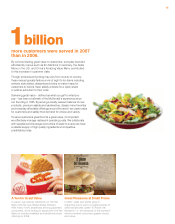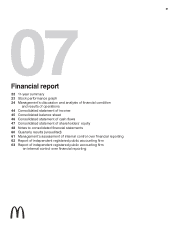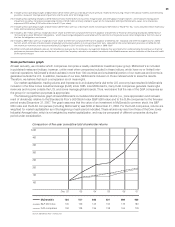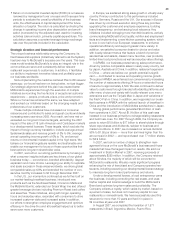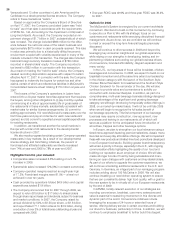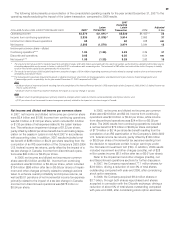McDonalds 2007 Annual Report Download - page 27
Download and view the complete annual report
Please find page 27 of the 2007 McDonalds annual report below. You can navigate through the pages in the report by either clicking on the pages listed below, or by using the keyword search tool below to find specific information within the annual report.• Return on incremental invested capital (ROIIC) is a measure
reviewed by management over one-year and three-year time
periods to evaluate the overall profi tability of the business
units, the effectiveness of capital deployed and the future
allocation of capital. The return is calculated by dividing the
change in operating income plus depreciation and amorti-
zation (numerator) by the adjusted cash used for investing
activities (denominator), primarily capital expenditures. The
calculation assumes a constant average foreign exchange
rate over the periods included in the calculation.
Strategic direction and fi nancial performance
The unique business relationship among the Company, its
franchisees and suppliers (collectively referred to as the System)
has been key to McDonald’s success over the years. This busi-
ness model enables McDonald’s to play an integral role in the
communities we serve and consistently deliver relevant
restaurant experiences to customers. In addition, it facilitates
our ability to implement innovative ideas and profi tably grow
our business worldwide.
Since implementing the customer-centered Plan to Win several
years ago, our focus has been on being better, not just bigger.
Our strategic alignment behind this plan has created better
McDonald’s experiences through the execution of multiple
initiatives surrounding the fi ve factors of exceptional customer
experiences — people, products, place, price and promotion.
While our focus has remained the same, we have adapted
and evolved our initiatives based on the changing needs and
preferences of our customers.
These multiple initiatives have increased our consumer
relevance and contributed to sales and guest counts worldwide
increasing every year since 2003. As a result, we have met or
exceeded our long-term fi nancial targets, excluding the 2007
impact of the sale of 18 Latin American and Caribbean markets
to a developmental licensee. These targets, which exclude the
impact of foreign currency translation, include average annual
Systemwide sales and revenue growth of 3% to 5%; average
annual operating income growth of 6% to 7%; and annual
returns on incremental invested capital in the high teens. We
believe our fi nancial targets are realistic and sustainable and
enable our management to focus on those opportunities that
best optimize long-term shareholder value.
In 2007, we built on our strong performance by focusing on
what consumer insights indicate are key drivers of our global
business today — convenience, branded affordability, daypart
expansion and menu choice. Leveraging our ability to replicate
and scale success in these areas worldwide, we drove global
comparable sales up 6.8% and extended the number of con-
secutive monthly increases to 56 through December 2007.
In the U.S., our momentum continued as we further built on
our market-leading breakfast business; introduced new
products such as the Southwest Salad, Cinnamon Melts and
the McSkillet Burrito; extended our Snack Wrap line and offered
greater beverage choices including Premium Roast iced coffee
and sweet tea. These initiatives, along with longer operating
hours and everyday value, resonated with consumers to drive
increased customer visits and increased sales. In addition,
our efforts to strengthen employee engagement and optimize
effi ciency in the drive-thru and at breakfast helped us to better
serve even more customers.
In Europe, we sustained strong sales growth in virtually every
country. Primary contributors to this performance included
France, Germany, Russia and the U.K. Our success in Europe
was driven by continued execution along three key priorities:
upgrading the customer and employee experience, building
brand transparency, and enhancing local relevance. Key
initiatives included reimaging more than 600 locations, actively
communicating McDonald’s food quality, nutrition and employment
facts and implementing a new kitchen operating system, which
is now in over half of our European restaurants, to enhance
operational effi ciency and support greater menu variety. In
addition, we satisfi ed consumer desire for choice and value
with locally-relevant menus that feature a blend of premium
sandwiches and salads, classic menu favorites, new products,
limited-time food promotions as well as everyday value offerings.
In APMEA, our business posted strong sales performance,
driven by positive comparable sales in nearly every country, led
by Japan, Australia and China. In addition, restaurant expansion
in China — where we believe our growth potential is signifi -
cant — contributed to revenue and operating income growth.
Throughout APMEA, we enhanced our convenience by increasing
the number of restaurants offering 24-hours or extended hours
of service to approximately 4,500. We also continued to deliver
value to customers through branded affordability platforms and
offer menu choice and variety with locally-relevant core menu
extensions such as the Teriyaki Mac in Japan and variations of
the Filet-O-Fish in China. In addition, we invigorated our break-
fast business in APMEA with the national launch of breakfast in
China and the introduction of McGriddles sandwiches in Japan.
Strong global performance generated $4.9 billion of cash
from operations in 2007. About $1.9 billion of this cash was
invested in our business primarily to reimage existing restaurants
and build new ones. For 2007 through 2009, the Company ex-
pects to return $15 billion to $17 billion to shareholders through
share repurchases and dividends, subject to business and
market conditions. In 2007, we increased our annual dividend
50% to $1.50 per share — more than six times higher than the
amount paid in 2002 — and repurchased over 77 million shares
for $3.9 billion.
In 2007, we took a number of steps to strengthen man-
agement’s focus on the core McDonald’s business and those
markets that have the largest impact on results. We sold our
investment in Boston Market in 2007, receiving proceeds of
approximately $250 million. In addition, the Company retained
about 50 sites, the majority of which will be converted to
McDonald’s restaurants. We also made signifi cant progress
enhancing the mix of franchised and Company-operated res-
taurants, including executing our developmental license strategy,
to maximize long-term brand performance and returns.
Under a developmental license, a local entrepreneur owns
the business, including controlling the real estate, and uses
his/her capital and local knowledge to build the McDonald’s
Brand and optimize long-term sales and profi tability. The
Company collects a royalty, which varies by market, based on
a percent of sales, but does not invest any capital for new
restaurants or reinvestments. We have successfully used this
structure for more than 15 years and had it in place in
59 countries at year-end 2007.
In August 2007, we completed the transition of 1,571
restaurants in Brazil, Argentina, Mexico, Puerto Rico,
25


